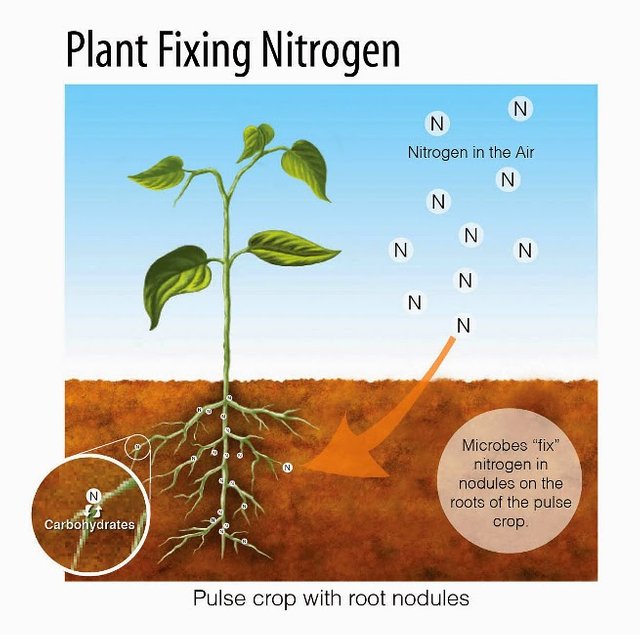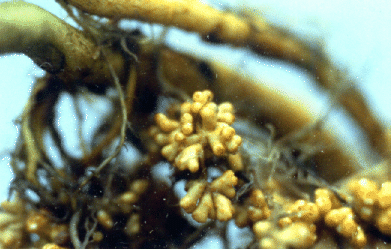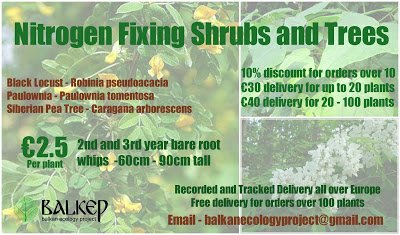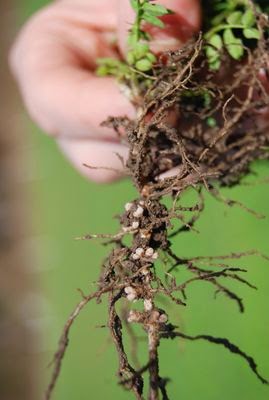Nitrogen Fixing Plants
Nitrogen is an essential nutrient for plant growth and development and although around 78% of the earth's atmosphere is nitrogen, plants cannot utilise this. Plants instead depend upon combined or fixed forms of nitrogen, such as ammonia and nitrate. Currently the majority of this nitrogen is provided to cropping systems in the form of industrially produced nitrogen fertilizers. Use of these fertilizers has led to worldwide ecological problems, such as the formation of coastal dead zones, and requires a high energy input to produce. Biological nitrogen fixation, on the other hand, offers a natural means of providing nitrogen for plants.

Legume aka Pulse Crop) in association with Rhizobium bacteria.
Biological Nitrogen fixation is an important component of organic gardening/farming, forest gardening and other agro-eco practices. Through a partnership with micro-organisms in their roots, some plants can turn atmospheric nitrogen into nitrogen fertilizers useful to themselves but also becoming available to their neighbors over time through root die back, leaf fall, and chop and drop pruning. These are known as the nitrogen fixing plants.
This is a mutually beneficial relationship with the plant providing carbohydrates obtained from photosynthesis to the microorganism and in exchange for these carbon sources, the microbes provide fixed nitrogen to the host plant.
While it does not replace the need to bring in other nutrients depleted by harvests such as phosphorus and calcium, nitrogen fixation provides a valuable biological source of an essential fertilizer.
There are two main groups of microbes that plants associate with in order to utilise the atmospheric nitrogen to fuel growth. They are Frankia and Rhizobium.
Frankia
Many plants partner with micro-organisms called Frankia, a group of Actinobacteria. These plants are known as the actinorhizal nitrogen fixers.

Frankia can be seen above as the yellow nodules forming around the roots of an Alder - Alnus sp.
Actinorhizal plants are found in many ecosystems including alpine, xeric, chapparal, forest, glacial till, riparian, coastal dune, and arctic tundra environments and can be found in the following plant families
Betulaceae, the birch family.
Myricaceae, the bayberry family.
Casuarinaceae, the Austraian “pines”.
Elaeagnaceae, the oleasters.
Rosaceae, the rose family.
Rhamnaceae, the buckthorn family.
These plants tend to thrive in nitrogen-poor environments and are often the pioneer species in plant communities playing an important role in plant succession.

Balkan Ecology Project Nitrogen Fixing plants
Rhizobium
By far the most important nitrogen-fixing symbiotic associations are the relationships between legumes (plants in the family Fabaceae) and Rhizobium and Bradyrhizobium bacteria. These plants are commonly used in agricultural systems such as alfalfa, beans, clover, cowpeas, lupines, peanut, soybean, and vetches.
The Rhizobium or Bradyrhizobium bacteria colonize the host plant’s root system and cause the roots to form nodules to house the bacteria. The bacteria then begin to fix the nitrogen required by the plant. Access to the fixed nitrogen allows the plant to produce leaves fortified with nitrogen that can be recycled throughout the plant. This allows the plant to increase photosynthetic capacity, which in turn yields nitrogen-rich seed.

Vetch - Vicia sp. with Rhizobium colonies clearly seen as nodules on the plant roots
I'll be writing in the near future on how to integrate nitrogen fixing plants into your plant communities in order to make the most of this biological source of fertility.
Excellent post. I use hairy vetch as a cover crop but you have to be careful with it. It adds so much nitrogen you may end up hurting your harvest in certain crops that don't like a lot of nitrogen like beans - been there did that. Upvote and resteem. Good job!
This is very interesting! I love how people are always innovating and finding the best ways to keep plants healthy
My little brother is trying to get into the whole organic farming thing. Last year he planted a field of some sort of peas and then plowed them under in the fall. I'll have to check up on how that turned out.